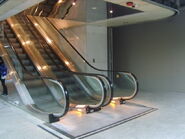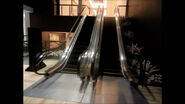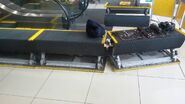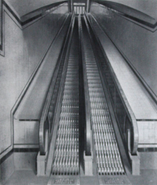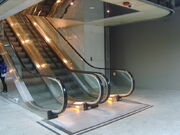
A set of O&K Kone escalators in a building but later modernized to Kone EcoMod escalators.
An escalator is a moving staircase that moves people between different floors of a building. They are powered by motors. The steps run on tracks. There is a handrail that moves with the escalator that people hold onto when riding the escalator. There is also an emergency stop button, which stops the escalator, and a key switch, that restarts the escalator, in the up or down direction.
History
Nathan Ames patented an escalator in 1859, that would either by water powered, or hand-crank powered. However, a working model was not built. The picture shows the patent for this type of escalator.
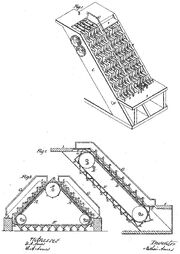
Leamon Souder got at least 4 patents for escalators, 2 for spiral escalators in 1889, but working models were not built.
Jesse W. Reno patented the cleat-type escalator in 1892.
George A. Wheeler patented the step-type escalator in 1892. He never built a step-type escalator, but the patents were sold to Charles Seeberger.
Jesse W. Reno installed the world's first escalator in 1896, at the Coney Island Old Island Pier in New York, NY.
Jesse W. Reno tried his escalator out again, by installing it at the Brooklyn Bridge in New York, NY. He removed the escalator a month later, after he was done testing it there.
Jesse W. Reno joined Otis Elevator Co, then retired later, after selling the patents to Otis Elevator Co.
Charles Seeberger started drawing an escalator model in 1895. This escalator model was different from modern escalators, as the escalator becomes flat at the end, where people get off sideways, and then there is most likely an angled combplate, though it is not safe to stay on the escalator at the end.
Piat made another type of escalator, consisting of a leather belt, in many pieces, attached together. A working model was installed at Harrods, London, United Kingdom, in 1898.
In 1899, Charles Seeberger joined Otis.
In 1900, the first commercially-sold escalator, and first step-type escalator was installed by Otis at the Paris 1900 Exposition Universelle, in Paris, France. The escalator won first prize. Other types of escalators were also on display.
Hallé made a different type of escalator.
George A. Wheeler made plans for another type of spiral escalator in 1905.
Jesse W. Reno installed a spiral cleat-type? escalator in 1906. However, it was never opened to the public.
Hocquardt got a patent for a different type of escalator in 1906.
Hocquardt later went out of business.
Charles Seeberger invented at least 2 more types of spiral escalators between 1906-1911, but models were never built.
Escalators were marketed under different names by other companies, as the name Escalator was trademarked by Otis, such as Peelle Motorstair, Westinghouse Electric Stairway, and Haughton Moving Stairs.
Gilbert Luna patented another type of spiral escalator in 1973, but a model was never built. A company to manufacture this product was most likely not found.
Mitsubishi installed the first modern spiral escalator in 1985.
Helixator, another type of spiral escalator, is more compact. A full size model does not exist, but there is a working scale model.
Nowadays, Schindler sells more escalators than any other company, and Otis does not sell as many escalators anymore, making Schindler as the largest escalator manufacturer in the world.
Types of Escalators
Step Type Escalator
The step type escalator is the common type of escalators today. The steps are usually metal, but very old step type escalators had wooden steps. Step type escalators can also go up/down, flat, then up/down again. On Otis Next Step escalators, the escalator steps are mounted on most likely hinged circles, and the track appears to be besides the steps, visible from above the steps. This type of escalator is designed to be safer than other step type escalators.
Wheelchair-accessible Escalator
Wheelchair accessible escalators have an attendant. If someone in a wheelchair needs to use the escalator, the escalator will be stopped. Once the wheelchair is on the escalator, the escalator is put in a special mode. 3 steps will level out, forming a platform. After that, some spikes will come out of the step closest to the lower landing of the escalator of the platform made out of 3 steps, preventing the passenger's wheelchair from rolling off of the platform. After that, the escalator will start moving slowly. The attendant will ride with the passenger, possibly for safety reasons. In at least some cases, the escalator will start moving in the opposite direction that it usually moves (possibly because there might only be 1 wheelchair accessible escalator going between 2 floors in many cases). After that, the escalator will speed up. Once the passenger in the wheelchair gets close to the top, the escalator will slow down. After the passenger in the wheelchair is no longer on the escalator, the escalator is then switched back to normal operation. Wheelchair accessible escalators might have only been installed in Japan. It is unknown if wheelchair accessible escalators are still made.
Belt Type Escalator
The belt type escalator was made by Piat. Users would stand on a flat(?) belt when using it. This type of escalator probably doesn't exist anywhere, anymore.
Cleat Type Escalator
The cleat type escalator had cleated metal, later wood treads, that are slanted. Some types of cleat type escalator look more like a belt, not an escalator (the belt type escalator?). This type of escalator is not known to exist anywhere, anymore.
Spiral Escalator
- Main article: Spiral escalator
There is also the spiral escalator, which uses curved steps, only manufactured by Mitsubishi since 1985.
Levytator
The Levytator is a new type of escalator, the freeform escalator, that can curve multiple times, in either direction. There are 2 escalators, which share a continuous loop of steps. The 2 escalators can curve differently. A working prototype has been built, but currently the inventor is looking for a company to mass-produce, and sell the new type of escalator. The steps are uniquely-shaped.
List of Escalator Models
These are some escalator models produced by elevator and escalator manufacturers.
Fujitec
Hitachi
- U Series
- V Series
- EX Series
- MX Series
- SX Series
- TX Series
Kone
- EcoMod (for full modernization, current model is version 2)
- TravelMaster
- TravelMaster 110
- TravelMaster 115
Mitsubishi
Otis
Sigma
- SCE
- SEE
- Vera
Schindler
Hyundai
- World Class
- Millennium
- H-Series
- S-Series
- Modular
- W-BT2 (discontinued)
- W-BB (discontinued)
ThyssenKrupp
Notable wooden escalators in the world
Wooden escalators currently in operation
- Town Hall Railway Station, Sydney, Australia
- St. Anna Pedestrian Tunnel, Antwerp, Belgium (1933)
- Macy's Herald Square department store, New York, United States
- Maastunnel, Rotterdam, Netherlands
- Emilio Mitre Station, Buenos Aires, Argentina
Wooden escalators that are no longer working
- Greenford Station, London, United Kingdom (decommissioned on 10 March 2014)[1] [2]
- Tyne Cyclist and Pedestrian Tunnel, Tyne and Wear, United Kingdom (4 total, 2 will be replaced with 1 or 2 inclined elevators, 2 will be preserved, possibly in functional condition when the tunnel reopens)
- Kaufmann's department store (now Macy's), Pittsburgh, Pennsylvania, United States (in the abandoned section of store)
- Wynyard Railway Station, Sydney, Australia (replaced with KONE escalators)
- La Motte-Piquet Grenelle Metro Station, Paris, France
Notable historic escalators in the world
- Baumanskaya Metro Station, Moscow, Russia (1944, replaced with new escalators in 2015)
- Kaufmann's department store (now Macy's), Pittsburgh, Pennsylvania, United States (1950s)
- Westfield San Francisco Centre (formerly The Emporium), San Francisco, California, United States
Notable longest and shortest escalators in the world
Longest systems
Central-Mid-Levels, Hong Kong
This escalator system connects Central, the central business district, and the Mid-levels. It has a total length of 2,600 feet (790 m), making it the longest outdoor escalator system in the world. The escalators were installed by French-based CNIM in 1993. It goes only one way direction, the direction may be changed depending on the rush hour. Those being replaced by Anlev Elex since 2018.[3]
Medellin, Colombia
Six escalators with a length of 1,260 feet (380 m) was opened in December 2011.
Cascade, Yerevan
This is an escalator system of 774 ft (236 m) length and 387 ft (118 m) height.
Ocean Park, Hong Kong
A long escalator system connecting two parts of the Park was made by Otis, with an overall length of 730 feet (220 m).
North America
The #1 and #2 longest escallators in North America are operated by the Washington Metropolitan Area Transportation Authority. The longest escalator, at 230 feet, is located at the Wheaton Metro Station in Wheaton, Maryland. The second longest, at 212 feet, is located at the Bethesda, Maryland Metro Station,
Longest individual escalators
Saint Petersburg Metro, St. Petersburg, Russia
Three stations of the Saint Petersburg Metro have the longest escalators in the world with 449 feet (137 m) long and 225 feet (68.5 m) long. The three stations that have these escalators are Ploshchad Lenina, Chernyshevskaya, and Admiralteyskaya.
Park Pobedy (Victory Park) Metro Station, Moscow, Russia
This is the longest escalator on Moscow Metro 208 feet (63.4 m) long.
CNN Center, Atlanta, Georgia, United States
There is a longest freestanding escalator in the world with 205 feet (62 m) long at the atrium of CNN Center in Atlanta, Georgia.
Mall @ Ciputra World, Surabaya, Indonesia
The escalators at Mall @ Ciputra World in the city of Surabaya, Indonesia have been recorded as the longest escalators in Indonesia by Museum Rekor Indonesia (MURI/Indonesian Record Museum). These escalators were installed by Hyundai Elevator.
MRT Blue Line Silom Station, Bangkok, Thailand
The escalators connected concourse level to platform 1 (To Hua Lampong Station) are currently the longest escalators in Thailand and South East Asia with 141 feet (43 m) long. These escalators were installed by Mitsubishi Elevator (Thailand).
Shortest escalator
The shortest escalator in the world is located in Kawasaki More's, Kawasaki, Kanagawa, Japan which was certified by Guiness Book of World Records in 1 October, 1989. It only has a length of 32.8 inches or 83 cm.
Notable spiral escalators in the world
Asia
- Landmark Tower, Japan
- Yokohama Minato Mirai 21, Yokohama, Japan
- Lotte World, South Korea
- The Venetian Hotel and Casino, Cotai, Macao, China
- Times Square, Causeway Bay, Hong Kong, China[4]
- Wheelock Place, Singapore (1994)[5]
- WTC Mangga Dua, Jakarta, Indonesia (2002)[6]
- Jeddah Hilton, Jeddah, Saudi Arabia
North America
- The Forum Shops at Caesars, Las Vegas, Nevada, United States
- Wynn Las Vegas, Las Vegas, Nevada, United States
- Westfield San Francisco Center, San Francisco, California, United States[7]
- Bloomberg Corporation Office, New York, New York, United States
- River Rock Casino Resort, Richmond, British Colombia, Canada[8]
Notes and references
- ↑ Installed by Waygood Otis in the 1930s. This was the last wooden escalator on the London Underground. A new inclined elevator has since been installed on it's place.
- ↑ New funicular at Greenford station
- ↑ [1]
- ↑ The only spiral escalators in Hong Kong, China.
- ↑ Currently the only spiral escalators in Singapore.
- ↑ Currently the only spiral escalators in Indonesia.
- ↑ The first spiral escalators in the Western Hemisphere.
- ↑ The first spiral escalators in Canada.
External Links
- Escalator article on Wikipedia
- Wooden step-type escalators in action
- Metal step-type escalators in action
- Wheelchair accessible escalator in action, going up
- Wheelchair accessible escalator in action, going down
- Cleat-type escalators in action
- Spiral escalators in action
- The Levytator in action
- hkelev.com - Escalator
- Escalators Basic Components - Part One ~ Electrical Knowhow
| Escalator and Moving Walkway |
|
Concept: Escalator control system • Escalator machinery • Spiral escalator • Escalator maintenance • Escalator modernization • Major alterations Escalator equipments: Escalator truss and balustrade • Escalator steps and step chains • Escalator handrails • Escalator skirt brushes • Emergency stop button • Energy-saving mode See also: List of elevator and escalator companies • Escalator landing plate guide • Floor numbering (Unlucky floor numbers) • Escalator incidents and accidents |
